The Wheelchair Guide
Your Wheelchair and Mobility Scooter Resource
The History of the Modern Manual Wheelchair
Friday, August 21st, 2009
Manual wheelchairs are one of the oldest types of wheelchairs known to man and records of their use can be traced back thousands of years. However, up until the end of the nineteenth century, there was very little standardization when it came to manual wheelchairs and they were often only available to people who had the resources to hire a professional builder.
Wicker and Wood: Early Wheelchair Designs
Towards the end of the nineteenth century, however, the wicker basket wheelchair began to become very popular. These wheelchairs provided a wicker seat for the person using the wheelchair, which had a very long and high back. These wicker wheelchairs had three wheels and were not only incredibly bulky, but also very heavy.
As a result of how these wheelchairs were designed, it was very difficult to transport a wicker wheelchair and it was also very difficult for the person using the wheelchair to move it on their own. Instead, they were forced to rely on nurses and family members to push the wheelchair if they wanted to move around.
In addition to the wicker wheelchairs, there were also several popular wooden wheelchairs, which were also incredibly heavy and difficult to transport, but were easier to self propel than the wicker wheelchair.
The Development of a Lighter Easier to Use Manual Wheelchair
Despite all their flaws, the wicker wheelchair would remain the standard in wheelchair design for over two decades until the 1930′s, when the first foldable tube framed manual wheelchair was developed. This new wheelchair was created by two inventors named Everest and Jennings and would come to be called the E & J Wheelchair.
Harry Jennings set out to build a newer lightweight wheelchair when he saw the difficulties his friend Herbert Everest was having using the standard wicker wheelchair. Together, they came up with a very innovative wheelchair design, which used hollow metal tubes and a foldable frame. By using metal tubes, they were able to create an incredibly strong wheelchair frame, which was also relatively lightweight.
The E & J Wheelchair frame could also be folded up and placed in a carriage or other vehicle, making easily traveling with a wheelchair possible for the first time. As the E & J Wheelchair was being developed, the build up to the Second World War was beginning and the E & J Wheelchair would soon have a number of users.
The First Electric Wheelchairs
The E & J wheelchair was also used as the base of the first electric wheelchair, when inventors in the 1950′s developed an electric motor that could be attached to the frame of an E & J wheelchair. This allowed the E & J wheelchair to be easily turned into an electric power chair and several companies began selling conversion kits for the E & J Frame.
The Wheelchairs of Today
The E & J manual wheelchair quickly became the standard and was used worldwide. Today, E & J wheelchairs are still available and their influence can be seen in virtually all modern manual wheelchairs.
Choosing the Right Electric Power Wheelchair
Friday, August 14th, 2009
For wheelchair users, the choice between an electric wheelchair and a manual wheelchair often revolves around the physical abilities of the wheelchair user. However, there are a number of other considerations, including personal preference, budget, and the place the wheelchair will be used.
For those that have decided to invest in an electric wheelchair, selecting the right power chair is very important, so it is important to understand some of their features and some of the different types of electric wheelchairs.
Rear-Wheel Drive Power Chairs vs Mid-Wheel Drive Power Chairs
There are several ways to categorize electric wheelchairs, but the drive system is one of the most important considerations. Power chairs are either driven by a mid-wheel drive system or a rear-wheel drive system. Understanding the difference between the two is important, because they both offer advantages and disadvantages.
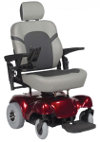 A rear-wheel drive power chair, as the name implies is driven by the rear wheels. Rear-wheel drive power chairs typically have only two sets of wheels, one in the front and one in the back, with the back wheels being responsible for moving the wheelchair. They may also have anti-tip casters, but as far as actual weight bearing wheels, there are usually only four. Since the weight of the wheelchair user is spread out evenly amongst the four wheels, the rear wheel drive system provides a very stable platform. This makes it a better choice for outdoor use or higher weight capacities.
A rear-wheel drive power chair, as the name implies is driven by the rear wheels. Rear-wheel drive power chairs typically have only two sets of wheels, one in the front and one in the back, with the back wheels being responsible for moving the wheelchair. They may also have anti-tip casters, but as far as actual weight bearing wheels, there are usually only four. Since the weight of the wheelchair user is spread out evenly amongst the four wheels, the rear wheel drive system provides a very stable platform. This makes it a better choice for outdoor use or higher weight capacities.
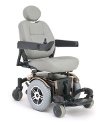 A mid-wheel drive power chair, on the other hand, has three sets of wheels and is driven by the middle set of wheels. This main advantage of a mid-wheel drive power chair is that it is very maneuverable, which results in a smaller turning radius than rear wheel drive system. However, the weight distribution is not as even on a mid wheel drive system, as the middle set of wheels supports the most weight. This makes them not quite as stable as a rear wheel drive system, but an excellent choice for indoor use, because mid-wheel drive wheelchairs are so very maneuverable.
A mid-wheel drive power chair, on the other hand, has three sets of wheels and is driven by the middle set of wheels. This main advantage of a mid-wheel drive power chair is that it is very maneuverable, which results in a smaller turning radius than rear wheel drive system. However, the weight distribution is not as even on a mid wheel drive system, as the middle set of wheels supports the most weight. This makes them not quite as stable as a rear wheel drive system, but an excellent choice for indoor use, because mid-wheel drive wheelchairs are so very maneuverable.
Portable Power Chairs vs Standard Power Chairs
Deciding whether to go with a portable power chair or a standard power chair is also an important consideration and depends a great deal on the needs of the user and where the electric wheelchair will be used.
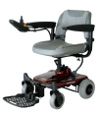 Portable power chairs, which are also sometimes called travel power chairs, are designed so that they can be taken apart into several easy to manage pieces. These individual pieces are light enough that they can usually be lifted by most people, so that the wheelchair can be transported without using a vehicle wheelchair lift. However, it is important to note that even though portable power chairs are designed to be as light as possible, the heaviest piece is usually around fifty pounds, so some might still find this too heavy to lift.
Portable power chairs, which are also sometimes called travel power chairs, are designed so that they can be taken apart into several easy to manage pieces. These individual pieces are light enough that they can usually be lifted by most people, so that the wheelchair can be transported without using a vehicle wheelchair lift. However, it is important to note that even though portable power chairs are designed to be as light as possible, the heaviest piece is usually around fifty pounds, so some might still find this too heavy to lift.
In order to reduce weight, portable power chairs have reduced features, such as smaller seats, and also typically have a slightly lower top speed, range, and weight capacity.
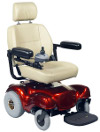 Standard Power Chairs, on the other hand, weigh a great deal more than portable power chairs and typically require a vehicle wheelchair lift to transport. Standard power chairs can typically still be easily disassembled, but the individual pieces are typically heavier than those of a portable power chair, with the heaviest piece usually weighing around ninety pounds.
Standard Power Chairs, on the other hand, weigh a great deal more than portable power chairs and typically require a vehicle wheelchair lift to transport. Standard power chairs can typically still be easily disassembled, but the individual pieces are typically heavier than those of a portable power chair, with the heaviest piece usually weighing around ninety pounds.
While standard power chairs are not as easily transported without a vehicle wheelchair lift, they are typically more comfortable and include more features. Standard power chairs usually have a more comfortable chair, a higher per-charge range, higher top speed, and a greater weight capacity than travel power chairs.
Increasing Accessibility With a Power Chair
Tuesday, August 11th, 2009
Today, many of those who use wheelchairs, opt to go with a electric wheelchair. Electric wheelchairs, which are also called power chairs, are popular for a number of reasons, including the fact that they can be operated with very little physical effort on the part of the wheelchair user.
Power chairs are not exactly a new invention and have been used for over fifty years. Back then, however, power chairs were simply manual wheelchairs that had been outfitted with an electric motor. The E & J Manual Wheelchair, which was incredibly popular at the time, actually had several do-it-yourself converter kits, which were sold to consumers, so they could transform their manual wheelchair into an electric wheelchair.
Today, power chairs remain to be very popular, but most do not share the same design as that of a manual wheelchair. Instead, most modern power chairs have a small plastic molded base, which contains the electric motor, axles, batteries, and other electrical components. A chair, often referred to as the captain’s chair, is attached to the base and often looks more like an office chair, complete with armrests, extra padding, headrest, and in some cases a reclining backrest.
Understanding Electric Wheelchair Controls
While the overall design of the power chair has greatly changed since it was first invented over fifty years ago, one thing that is still very similar is the default control system. The standard control system on electric wheelchairs is a joystick control that is attached to one of the chair’s armrest. This allows the power chair to be moved in any direction by the push of a button. However, unlike the original electric wheelchairs, modern wheelchairs also have a throttle setting to control the speed of the wheelchair. They are also much more sensitive than the first wheelchair controls, deftly turning and controlling the wheelchair in a very fluid motion.
While the joystick control system is the default control for most electric wheelchairs, there are many people who are unable to use it. For these people, a number of alternate controls are available, which can allow the power chair to be easily controlled even by people who are unable to move their hands.
Many of the popular alternate wheelchair controls are based around using the head. There are systems that allow the wheelchair to be controlled by head movements and also some that use the individuals breath to move the wheelchair. There are also a great number of experimental wheelchair controls in the works. This includes using magnets on the persons tongue and even several that rely on a brain computer interface, which uses signals from the users brain to control the electric wheelchair.
In addition to alternate control systems that make it easier for the wheelchair user to control their wheelchair, there are also a number of control schemes intended to make it easier for caretakers to move the wheelchair. The most basic is a simple remote control, either wireless or directly attached to the wheelchair, which can be used by someone walking next to the power chair. There are also much more advanced systems, which can learn the floor plans of a home or other area and then be programmed to move the wheelchair to any area in the home.
Electric wheelchairs are very powerful tools and remain to be one of the most popular accessibility tools. While these devices have been around for over fifty years, modern power chairs are much more reliable, durable, and powerful than their predecessors.
Modern Power Chairs
Wednesday, August 5th, 2009
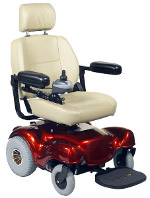 Electric wheelchairs, or power chairs, are today a very important accessibility aid that greatly improves the lives of millions of people every year. While modern power chairs offer similar functionality to the first electric wheelchairs developed almost 60 years ago, their design and reliability has changed a great deal.
Electric wheelchairs, or power chairs, are today a very important accessibility aid that greatly improves the lives of millions of people every year. While modern power chairs offer similar functionality to the first electric wheelchairs developed almost 60 years ago, their design and reliability has changed a great deal.
Power Chair Range and Speed
One of the biggest changes to the modern power chair is that it now uses a much stronger and more reliable electric motor. The batteries are also much improved, offering a much greater per charge distance. This not only means the wheelchair can be driven further faster, but also that it can support more weight and preform better over uneven terrain. It is not uncommon for an electric wheelchair to be able to travel more than 10 miles on a single charge, with a number of power chairs having a range between 15 and 20 miles. The top speed is also significantly higher, with most power chairs traveling at speeds at or above 5 miles per hour.
General Power Chair Design
While from a functionality and reliability standpoint, having an improved electrical system is one of the biggest differences between modern electric wheelchairs and their predecessors, there are also a significant number of changes involving the design of the device. The original electric wheelchairs were simply manual wheelchairs that had been outfitted with an electric motor and battery. However, today, most electric wheelchairs share a much different design.
This includes a much smaller molded plastic base, which contains the electrical components of the wheelchair. A seat is installed upon this plastic base and is usually referred to as the captain’s chair. Depending on the type of wheelchair, the captain’s chair could be relatively small, or it could resemble a high end office chair, with a high back and extended armrests. In either case, it is much different than the chair used on most manual wheelchairs, which is made out of slats of vinyl.
Power Chair Controls
There are in fact a great number of improvements and changes that have been made to the power chair over the years, many of these mechanical, but the standard electric wheelchair control scheme is the same. This is of course the joystick control system, which is found on most electric wheelchairs. The joystick is attached to the armrest of the wheelchairs chair and allows the power chair to be controlled by only the push of a finger.
There are also a number of alternate wheelchair controls that are commonly used, made available for people who are not able to physically able to use a standard joystick control scheme. There are many different types of controls, often aided by computers, allowing power chairs to be controlled by the angle of ones head, an individuals breath, or other parts of their body’s. For caretakers, there are also several popular remote control systems that can be attached to a standard power chair, allowing the unit to be controlled by someone walking behind it.
Even though the modern power chair shares a number of similarities with the first electric wheelchairs in regards to the functionality, they are actually quite different. Not only do they have a completely different design, but the modern power chair is much more reliable and durable.
Manual Wheelchairs vs Electric Wheelchairs
Monday, August 3rd, 2009
Wheelchairs are a popular mobility aid that greatly improves the lives of millions of people all over the world. The manual wheelchair has been around for thousands of years, while the electric wheelchair is relatively new, with the first electric wheelchair being developed in the early 1950′s. Choosing between a manual wheelchair or an electric wheelchair is an important decision that should be based upon the needs and requirements of its user.
Consider the Physical Capabilities of the User
One of the most important considerations when choosing between a manual or electric wheelchair is the physical abilities of the wheelchair user. Using a manual wheelchair requires a lot of upper body strength and can be very tiring even for someone who is in perfect health. In addition to having fairly good physical fitness, it is also necessary to use both arms to push a manual wheelchair.
An electric wheelchair, on the other hand, can be controlled by only using a single finger and there are also a number of other alternate controls as well. Alternate wheelchair controls include head controlled wheelchairs and breath controlled wheelchairs. This allows even someone with greatly reduced physical capabilities to use a wheelchair.
Consider Where the Wheelchair Will Be Used
In addition to considering the condition of the wheelchair user, it is also necessary to consider where the wheelchair will be used and how far it will be driven everyday. If the wheelchair is primarily going to be used around the home, then a manual wheelchair might be a good choice, because even though it requires a good deal of physical effort, moving between rooms does not present a very large traveling distance.
If, on the other hand, you intend to use the wheelchair away from home across a larger distance, an electric wheelchair might be a better choice. As an example, traveling across a college campus would be much more strenuous than traveling between rooms in a house. The per charge range of an electric wheelchair varies, but most can travel between 10 and 20 miles without needing to be recharged.
In addition to considering how far one will be traveling in the wheelchair, it is also important to consider what type of terrain will be traveled over. It takes much more effort to move up and down hills than it does to move across straight ground in a manual wheelchair. Some electric wheelchairs are also much better choices for off road use, although it is also possible to buy off road wheels for manual wheelchairs.
Consider the Cost of the Wheelchair
Finally, it is also important to consider the wheelchair users budget, when deciding between a manual wheelchair or an electric wheelchair. There are of course exceptions to the rule on both sides, but typically a manual wheelchair costs significantly less than an electric wheelchair. Usually a quality electric wheelchair costs between $3,500 and $7,000, while a manual wheelchair costs between $300 and $1,500.
When considering cost, it is important to take into account insurance programs, such as Medicare or Medicaid, which will often help to offset the cost of a wheelchair. For example, in the case of Medicare, typically 80% of the cost of the wheelchair is covered, so this can greatly offset the expense of an electric wheelchair.
Electric Wheelchairs of Today and Yesterday
Sunday, July 19th, 2009
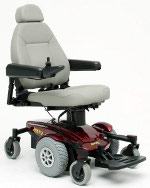 Today, electric wheelchairs are essential mobility vehicles, used by millions of people all over the world. Electric wheelchairs have changed a great deal over the last fifty years and remain incredibly popular, especially among those who are unable to use a manual wheelchair.
Today, electric wheelchairs are essential mobility vehicles, used by millions of people all over the world. Electric wheelchairs have changed a great deal over the last fifty years and remain incredibly popular, especially among those who are unable to use a manual wheelchair.
When electric wheelchairs, or power chairs, were first invented, an electric motor was placed onto a manual wheelchair, allowing it to be controlled electronically. This was a major improvement, which greatly increased the accessibility of those who were otherwise unable to get around by themselves. A number of companies quickly formed to sell these manual wheelchair converter kits, which were usually based off of the E & J Wheelchair.
While it is still possible to buy manual wheelchair converter kits, most electric wheelchairs today consist of a molded plastic base, which contains the electronic components of the wheelchair, with a large comfortable chair fitted onto the base. As a result, most modern electric wheelchairs can not be reverted into a manual wheelchair should the battery die, but they are much more powerful and often include a lot of neat features.
Most electric wheelchairs are controlled by using a simple joystick, which is secured to the arm of the chair. The joystick can be configured for left hand or right hand use, which is typically done by the manufacturer, although it is typically possible for the user to change this as well. In addition to the joystick, a simple throttle, which controls the speed of the wheelchair, is also usually on the arm of the chair. For those who are not able to use the standard wheelchair control, alternative controls are also available.
Many of todays electric wheelchairs share a number of similarities, both in the way they are designed, as well as the way they look. Typically, electric wheelchairs are classified by the type of drive system, either mid-wheel drive or rear wheel drive, as well as by how easy it is to transport the wheelchair.
In a mid-wheel drive electric wheelchair, the base of the wheelchair will typically have three rows of wheels. The middle row is the row that is responsible for moving and turning the wheelchair, while the other two rows help provide support. A mid-wheel drive system is extremely maneuverable, which makes it great for indoor use. In a rear wheel drive wheelchair, there will usually only be two rows of wheels, with the rear wheels being responsible for moving and turning. While not quite as maneuverable as a mid-wheel drive wheelchair, a rear wheel drive wheelchair does provide a little bit more stability because the weight is more evenly distributed between the base of the chair.
The other way that power chairs are classified is by how easy it is to transport them. Travel wheelchairs are available, which are designed to be taken apart to make it easier for them to be transported in a vehicle. There are even some folding electric wheelchairs, which closely resemble the design of a manual wheelchair. If you do not have a travel wheelchair, you will likely need a wheelchair lift to transport the device in a vehicle. This is because even though most electric wheelchairs can be disassembled, the individual pieces of a non-travel wheelchair can be very heavy.
The electric wheelchair has come a long way over the last fifty years and is today a very important tool for millions of people all across the World.
Electric Wheelchairs
Thursday, June 4th, 2009
The wheelchair is one of the oldest types of medical equipment known to man. Its uses can be traced back thousands of years and every year, the wheelchair greatly improves the lives of the mobility challenged. The electric wheelchair, on the other hand, is a much newer device and has only been available for about sixty years.
The first electric wheelchairs, which were developed during the nineteen-fifties, were simply manual wheelchairs that had been outfitted with an electric motor. They have changed a great deal since then, although there are a few that still share a similar design to these early electric wheelchairs. Most however, have a power base, which contains the electric motor, wheels, and batteries, with a chair mounted to the top of the base.
To control the wheelchair, a simple joystick is attached to the arm of the chair and the wheelchair user can simply push the joystick in the direction they wish to go. Most will also have a button for a horn, a battery meter, and a speed adjustment mounted in the armrest.
While for many people the joystick will provide an adequate control system, there are some who lack the ability to use this type of control and must instead use an alternate wheelchair control system. For instance, it is possible to control the wheelchair with head movements, breath, or even with a remote control. Currently, there are several companies working on a brain controlled wheelchair as well, which will eventually allow the wheelchair user to control their wheelchair with thoughts.
There are many different models of electric wheelchair available and a number of different manufacturers as well, but most electric wheelchairs can usually be classified as either rear wheel drive wheelchairs or mid-wheel drive wheelchairs.
A rear wheel drive wheelchair usually has 4 wheels and the two rear wheels are responsible for moving the wheelchair. They provide a very sturdy and stable base, because the weight is evenly distributed across the four wheels.
A mid-wheel drive wheelchair usually has 6 wheels. The set of wheels in the middle is used to move the wheelchair and the other wheels, which are located on the front and back of the base, are used to provide stability. A mid-wheel drive wheelchair is incredibly maneuverable, however the weight is not as evenly distributed, so it will not be as stable as a rear wheel drive wheelchair.
While the rear wheel and mid-wheel drive wheelchairs are the most common, there are also foldable electric wheelchairs, which use a frame that is similar to that of a manual wheelchair. These are popular for traveling, but lack many of the features of the other types of electric wheelchairs.
The electric wheelchair has greatly evolved over the last fifty years and today provides a very reliable and dependable way to allow a mobility challenged individual to get around.
What are Power Chairs?
Tuesday, June 2nd, 2009
The wheelchair is easily one of the most important medical devices of all time and its roots can be traced back thousands of years. Today, more and more people are using electric wheelchairs.
Electric wheelchairs were first developed in the nineteen-fifties when an electric motor was added to a manual wheelchair. They quickly became popular because a manual wheelchair requires a great deal of physical effort to use and a lot of upper body strength, making them impossible to use for many who are mobility challenged. An electric wheelchair, on the other hand, can be moved by only lifting a finger and there are a number of alternate wheelchair control systems available as well, such as a system that allows the wheelchair to be controlled by the breath of the user.
There are many manufacturers of electric wheelchairs, but two of the most well known are Golden Technologies and Pride Mobility. Both of these companies offer a wide assortment of home medical equipment, including a number of different electric wheelchairs. There are of course many other manufacturers, including ShopRider, so it is a good idea to explore all of your options when shopping for an electric wheelchair.
While there are many different models of electric wheelchairs available, they can typically be classified as either rear-wheel drive, mid-wheel drive, or travel wheelchairs.
Rear-wheel drive wheelchairs are propelled by their rear wheel and the weight of the user is evenly distributed across the electric wheelchairs base. Mid-wheel drive wheelchairs feature three rows of wheels, with the row in the middle being responsible for moving the wheelchair. A mid-wheel drive wheelchair is much more maneuverable than a Rear-wheel drive wheelchair, but the weight is not as evenly distributed, so it does not provide as stable of a platform. For most, the difference is negligible, but in some outdoor situations and for those who require a higher weight capacity, the rear-wheel drive wheelchair might be the best choice.
Travel wheelchairs come in several different designs, but are lighter and easier to transport than other electric wheelchairs. Some are designed so that they can be taken apart into easy to manage pieces and others share a design similar to a steel tubed manual wheelchair, allowing them to be folded up when not in use. They typically have a shorter range and fewer features, but can usually be transported without requiring a vehicle wheelchair lift, which would typically be required to transport non-travel wheelchairs.
For millions of people across the globe, the electric wheelchair allows for increased mobility and accessibility, allowing them to effortlessly move around.
Electric Wheelchairs for Seniors
Thursday, May 21st, 2009
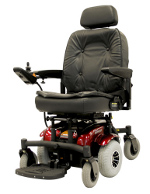 Electric wheelchairs, which are often also called power chairs, offer the advantage of a manual wheelchair, in that they are very maneuverable. However, unlike manual wheelchairs, power chairs are powered electronically, so they can typically be operated very easily, requiring very little physical activity of the senior.
Electric wheelchairs, which are often also called power chairs, offer the advantage of a manual wheelchair, in that they are very maneuverable. However, unlike manual wheelchairs, power chairs are powered electronically, so they can typically be operated very easily, requiring very little physical activity of the senior.
A simple joystick control scheme is most popular for controlling electric wheelchairs, which allows the senior to simply push the joystick. The joystick, which is attached to the arm of the power chair, then moves the wheelchair in the direction they wish to travel. Of course, there are a number of alternate wheelchair control systems available as well, including breath controlled systems and remote controlled systems, which are often used by caretakers.
A Brief Background on Electric Wheelchairs
The first electric wheelchairs, which were developed in the early 1950′s, were simply adapted E & J manual wheelchairs.
An electric motor was attached to the manual wheelchair, which was controlled using a simple joystick control scheme, although even during the 1950′s, researchers were already coming up with alternate control schemes. One popular method was to mount something similar to a joystick near the individuals head. They could then use their face to control the electric wheelchair.
The Modern Electric Wheelchair
Today, while some portable electric wheelchairs do use a traditional steel tubed folding wheelchair design, most look much different from a traditional manual wheelchair. Instead, an electric motor and battery is contained in the base of the wheelchair, usually covered by molded plastic.
A captains chair, which, depending on the cost of the power chair, often rivals that of most office chairs, both in comfort and durability, is mounted on the base of the wheelchair. The captains chair often reclines and swivels, to facilitate comfort and make transferring into and out of the wheelchair easier. Some even include an electric lifting system to raise and lower the chair.
While many power chairs share a similar design, one way they are often classified is by their wheels. A mid-wheel power chair features one set of large wheels in the middle of the base and one set of smaller wheels on the front and back of the base. The larger wheels are what does all of the work and are powered by the electric motor. The smaller set of wheels on either side of the drive wheels, provide extra support and stability.
The mid-wheel electric wheelchair offers the advantage of excellent maneuverability. It can turn in much smaller spaces. However, in some cases it might not offer the same stability as a rear-wheel drive wheelchair. This is because the center of balance for a mid-wheel wheelchair is in the middle of the power chairs base.
The other common type of electric power chair is the rear wheel drive wheelchair. These feature a set of rear wheels, which depending on the model might be slightly larger, and a set of front wheels, giving it four wheels in total. The rear wheels, are powered and what actually moves the power chair.
The rear wheel drive wheelchair does not offer the same maneuverability that a mid-wheel power chair does, but does offer increased stability. This is because the weight of the occupant is more evenly distributed across the base, making a wider center of balance.
As is the case with manual wheelchairs, power chairs, both mid-wheel and rear wheel drive models, include anti-tip casters to prevent the wheelchair from tipping over backwards.
Advantages of Electric Wheelchairs
One of the major advantages that an electric wheelchair offers is that it does not require much effort to use. Simply push the joystick and the power chair will move, with many offer very small turning radius and sensitive controls. The speed is often adjustable and some models can reach speeds of over 10 miles per hour.
The range of a power chair varies, but most can travel at least 5 miles without requring a recharge. Some can travel upwards of 20 or 30 miles per charge, but this often is dependent on the terrain and weight of the occupant. For example, if you decided to drive around the hills of San Fransisco, the battery would wear down much quicker than it would when used on flat land.
Along the same lines, if the rider weighed 300 pounds, the battery would wear down quicker than if they weighed 150 pounds. Often, an extra battery pack is purchased for those who use the power chair continuously, as this way when one battery pack wears down, it can be removed and charged, and the fresh battery pack used.
Electric Wheelchairs and Seniors
While the electric power chair can be an excellent device, especially for seniors, it is often cost prohibitive.
Of the three main mobility options, manual wheelchairs, electric wheelchairs, and mobility scooters, electric wheelchairs are by far the most expensive. When compared to mobility scooters, electric wheelchairs often also have a lower range, lower top speed, and are not as well suited to rough terrain. However, for indoor use, they are usually superior to scooters.
Electric Wheelchairs
Monday, November 10th, 2008
The first electric wheelchair was developed in the early 1950′s. These early power chairs took an existing wheelchair, usually the E & J manual wheelchair, and outfitted them with an electric motor. These chairs quickly became popular and today millions of people benefit from electric power wheelchairs.
While today, electric wheelchairs are much more advanced than the first electric power chairs, they do share one similarity. The joystick control system was first developed in the fifties and is still one of the most popular means of controlling an electric wheelchair today. The joystick can be mounted on either side of the chair and usually only requires a little bit of pressure for the occupant.
There are many people, however, who can not use this type of control system, so there are also several types of alternate control methods that can be used with an electric wheelchair that do not require the use of the occupants hands.
An electric wheelchair and a manual wheelchair share many similarities in regards to the services they provide, but they are also very different. Since power chairs are electric powered, it is necessary to charge them after each use. The range that a power chair can travel per charge depends largely on the model, but the places that you choose to use it can also effect the range. For example, driving the power chair up a very steep hill will cause the chair to loose its charge quicker. Most can travel a minimum of ten miles on a single charge.
An electric wheelchair will typically have a minimum of 4 wheels, but some have six. In these cases, the extra wheels are more for support. The way the wheelchair is propelled will help determine how many wheels it has. A traditional electric wheelchair usually only has four wheels and the rear wheels are what actually move the chair. These are called rear wheel drive power chairs.
A, relatively, new type of wheelchair has become very popular over the last ten years. These chairs use a mid-wheel drive system, a set of stability wheels located in front and in the back of the chair. The mid-wheel drive wheelchair is incredibly maneuverable and this makes it great for indoor usage.
Electric wheelchairs are incredibly popular today and many people would not be able to get around with them.